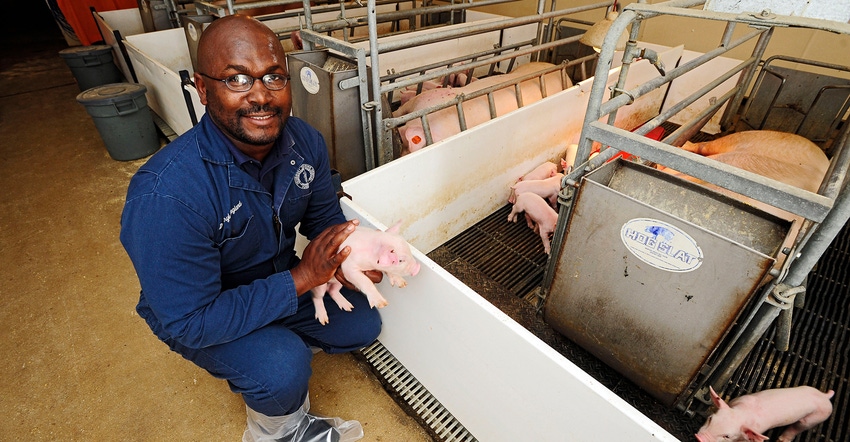December 20, 2021

Indiana is seeing a decrease in large-animal veterinarians but an increased demand for veterinary services among large-animal producers. It’s a serious issue not only in Indiana but also nationwide, as farmers experience the demand for veterinary care without the timely service they’ve come to expect.
Since the COVID-19 pandemic, people have adopted more pets than average, leading to an increased demand for veterinary care. As a result, pet owners are unable to schedule with vet practitioners, and emergency clinics are filled with non-emergency cases.
The result is that farmers are not getting adequate animal care to keep herds and flocks healthy. The shortage of care creates a significant concern for animal welfare, according to Denise Derrer Spears, director of public information for the Indiana State Board of Animal Health.
“We are always concerned about high consequence of animal diseases such as foot-and-mouth disease, because we don’t have the capacity to go out on every farm,” Spears says.
The economic challenge of finding large-animal veterinarians is partly due to a dynamic shift in the career. The demographic profile of individuals entering veterinary school is mostly women, as shown in recent data from the Purdue University College of Veterinary Medicine.
Between Indiana residents and non-residents projected to graduate in 2024 and 2025, there is an average of 12 male students compared to an average of 71 female students.
Data from students in their third and fourth years of the DVM program show that between the two classes, there are 17 students who have declared interest in large-animal practice compared to 49 interested in a mixed-animal track. Last year, 10 graduates entered large-animal practices out of 84 graduates.
Economics poses challenges
Today, fewer farmers often feed thousands of animals per operation. At the same time, more are taking on hobby farming and spreading out across the state. The economic challenges with this change have impacted the large-animal veterinary industry in more ways than one, according to Jim Weisman, assistant dean of college affairs at Purdue’s College of Veterinary Medicine.
“The need for large-animal veterinarians for farms with large numbers of animals has decreased as the number has decreased,” Weisman said. “Now we are seeing smaller farms and even more hobby farms that significantly spread out the density of farms. That makes it difficult for large-animal veterinarians in each area to cover all the smaller farms since they are much more spread out.”
Practices that serve a large geographic area with fewer farms are not in the best economic interest of veterinarians. The time needed to access the farm reduces the amount of time a veterinarian can spend working with animals.
Increased travel time challenges the practice to meet its financial needs to pay for inventory, support staff and other necessities. The owner of the farm and animals is then less able to pay when considering the animal’s production value for veterinary services at the billable rate required to balance travel fees. Costs for gas, inventory and time are higher compared to costs for veterinarians who are close by.
Farmers need large-animal veterinarians; however, costs become prohibitive as large-animal veterinarians turn their focus to small animals. Fewer veterinarians are available to treat large animals.
Education expense
According to Weisman, new veterinary graduates must balance their education debt with the new financial expenses associated with being a practicing veterinarian.
“The average [debt] for a student graduating from the Purdue University College of Veterinary Medicine in 2021 is $186,000,” Weisman says. “This debt load demands debt service that must be met with starting salaries greater than what some rural areas are able support. In 2021, the average starting salary for all graduates entering private practice was $101,000, with the national starting salary for all graduates in private practice being $98,000.”
Although there are veterinary students and graduates who are interested in large-animal practice, many are more interested in the industry and public health aspect of veterinary medicine. Pursuing this interest, graduates enter the profession working for government agencies such as USDA.
Veterinarians in this field are essential to the protection of the nation’s food supply, but that leaves fewer practicing veterinarians within a rural area or large-animal practice. These competing interests differ from the simple supply and demand of a private practice.
Help for student loans
Federal government programs aimed at helping regions recruit and retain veterinarians such as the Veterinary Medicine Loan Repayment Program pay up to $25,000 a year for veterinarians who are practicing in designated underserved areas. Areas are chosen by each state, and interested veterinarians must complete an application process.
“This type of program is becoming more essential if we want to attract veterinarians to rural areas,” Weisman says. “A key reason is not that the veterinarians do not want to practice in these areas, but really it is that the animal density and case load does not lend itself to enough production for the veterinarian to meet their financial obligations.”
The federal loan repayment program is a bridge that can help supplement the veterinarian’s income and make the lower-income-producing area a feasible area to practice, Weisman adds.
Wondercheck is a senior in the Purdue University ag communications program.
You May Also Like




